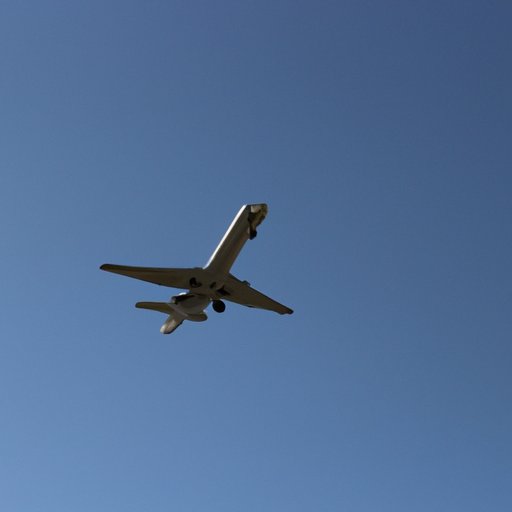Introduction
Airplane speed is an important factor to consider when traveling by air. It affects the amount of time it takes to get from one destination to another and the level of comfort on board the aircraft. But how fast do airplanes actually travel? This article will explore the factors that affect airplane speed and how modern technology has impacted the speed of airplanes.
Comparing the Speed of Different Airplanes
There are a variety of different types of commercial aircraft, each with its own specifications and capabilities. The most common type of aircraft is the narrow-body jet, which includes planes like the Boeing 737 and the Airbus A320. These planes typically have a cruising speed of around 500 mph (805 km/h). Long-haul jets such as the Boeing 787 and the Airbus A350 have a cruising speed of around 550 mph (885 km/h). Regional jets such as the Embraer E-Jet have a cruising speed of around 450 mph (725 km/h).
The speed of an airplane is determined by a variety of factors, including its size and weight, engine type and thrust, and aerodynamic design. All of these factors play a role in determining the overall speed of an aircraft.

Exploring the Factors That Affect Airplane Speed
The size and weight of an airplane can have a major impact on its speed. Generally speaking, larger and heavier planes tend to be slower than smaller and lighter ones. Aircraft designers must carefully balance the weight of the plane with its fuel efficiency in order to achieve the desired speed.
The type of engine and the amount of thrust it produces are also important factors in determining an airplane’s speed. Turbofan engines are the most common type of engine used on commercial aircraft, and they provide a great deal of thrust. However, other types of engines such as turboprops and turbojets can also be used and can provide even greater thrust.
The aerodynamic design of an aircraft is also critical in determining its speed. Aircraft designers must carefully craft the shape of the plane in order to minimize drag and maximize lift. This allows the plane to move through the air more efficiently, resulting in higher speeds.
Examining the Impact of Modern Technology on Airplane Speed
Advances in material science have had a major impact on the speed of airplanes. Aircraft designers now have access to stronger and lighter materials, allowing them to build airplanes that are both faster and more fuel efficient. Computers and automation have also made it easier for aircraft designers to create planes with complex shapes and designs that reduce drag and increase lift.
The development of new engines has also had a major impact on the speed of airplanes. Turbofans are now more powerful and efficient than ever before, allowing planes to reach higher speeds with less fuel. Jet engines have also seen major advances in recent years, providing even greater thrust and efficiency.
Analyzing the Relationship Between Airplane Size and Speed
Smaller airplanes are generally faster than larger ones due to their lower weight and better aerodynamic design. However, bigger planes are usually more fuel efficient and can carry more passengers and cargo. As a result, there is a trade-off between speed and efficiency when it comes to choosing the right size of airplane.

Investigating the Physics Behind Airplane Speed
The physics behind airplane speed can be explained using the principles of lift and drag. Lift is created when the wings of an airplane deflect the air downwards, creating an upward force known as lift. Drag is created when the air molecules rub against the surface of the airplane, creating resistance. The combination of lift and drag determines the speed of an airplane.
Newton’s laws of motion also play a role in determining the speed of an airplane. According to Newton’s second law of motion, the acceleration of an object is proportional to the force acting on it. This means that the more thrust an airplane’s engines produce, the faster it will accelerate. Bernoulli’s principle also plays a role in determining the speed of an airplane. According to this principle, the pressure of a fluid decreases as it moves faster. This means that an airplane will experience less drag as it moves faster through the air.

Discussing the Safety Implications of Airplane Speed
As airplanes become faster, there is an increased risk of accidents due to pilot error or mechanical failure. In addition, emergency response times may be reduced due to the increased speed of aircraft. As a result, it is essential that pilots receive adequate training in order to safely operate faster aircraft.
Conclusion
In conclusion, the speed of an airplane is determined by a variety of factors, including its size and weight, engine type and thrust, and aerodynamic design. Advances in material science, computers, and automation have all had a major impact on the speed of airplanes. Smaller airplanes tend to be faster than larger ones, but bigger planes have greater fuel efficiency. Finally, the physics behind airplane speed involve the principles of lift and drag, Newton’s laws of motion, and Bernoulli’s principle. Increased airplane speed can lead to increased risk of accidents, so it is important that pilots receive adequate training.
Further research should focus on the potential for new technologies to further increase the speed of airplanes while maintaining safety. Additionally, research should be done on the environmental impact of faster airplanes and how to mitigate any negative effects.
(Note: Is this article not meeting your expectations? Do you have knowledge or insights to share? Unlock new opportunities and expand your reach by joining our authors team. Click Registration to join us and share your expertise with our readers.)
